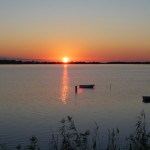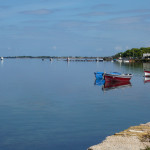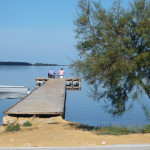The lagoon of the Stagnone has very shallow waters, from a few centimetres to a maximum depth of 3 meters. Therefore, the high temperature of the water allows the proliferation of particular animal species: anemones, murex, used by the Phoenicians to make the famous red dye they exported throughout the Mediterranean, and the Posidonia Oceanica (known as Neptune Grass), a plant that only grows in totally clean waters and that houses a variety of animal and vegetal species.
Until a few decades ago it was possible to walk the so-called Phoenician Road, a thin stretch of land which connected the island of Motya to the mainland. In recent times, however, the road has been submerged, due to changes in the tidal patterns. Motya is nevertheless easily accessible by boat in just a few minutes and a regular service connects it to the mainland.
A stroll along the coast of the Stagnone will bring you to another picturesque sight: with their multi-coloured tanks, the ancient windmills and the blinding white mounds of salt, the sea-salt mines create a remarkably suggestive scenario.
The shallow waters and the steady winds that characterize the lagoon make it an ideal spot for water sports such as wind and kite-surfing. Numerous schools organize courses for amateurs and experts alike, and can also provide the equipment if necessary.
Few things can compare to the experience of going out for a ride or for a paddle around the Stagnone at sunset, taking in the sight and admiring the wildlife without disturbing this enchanting tranquillity.







